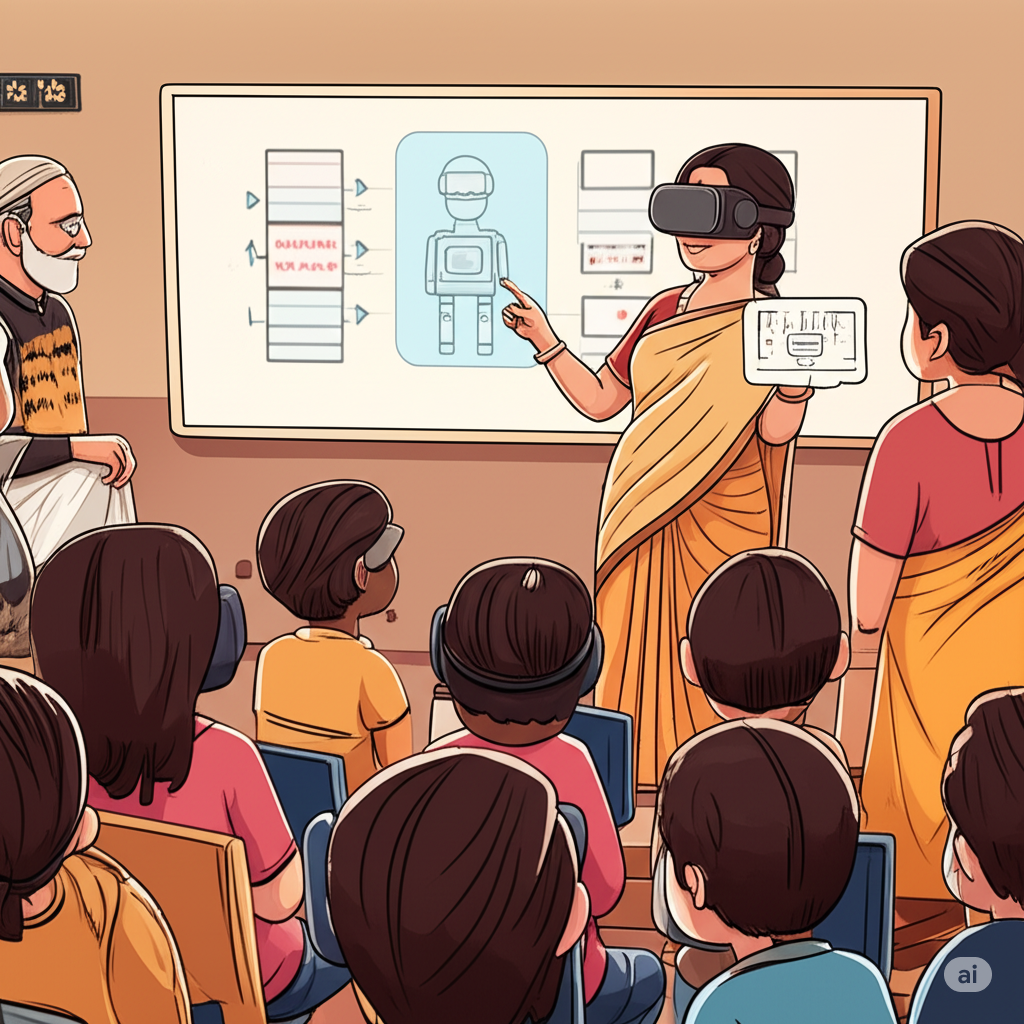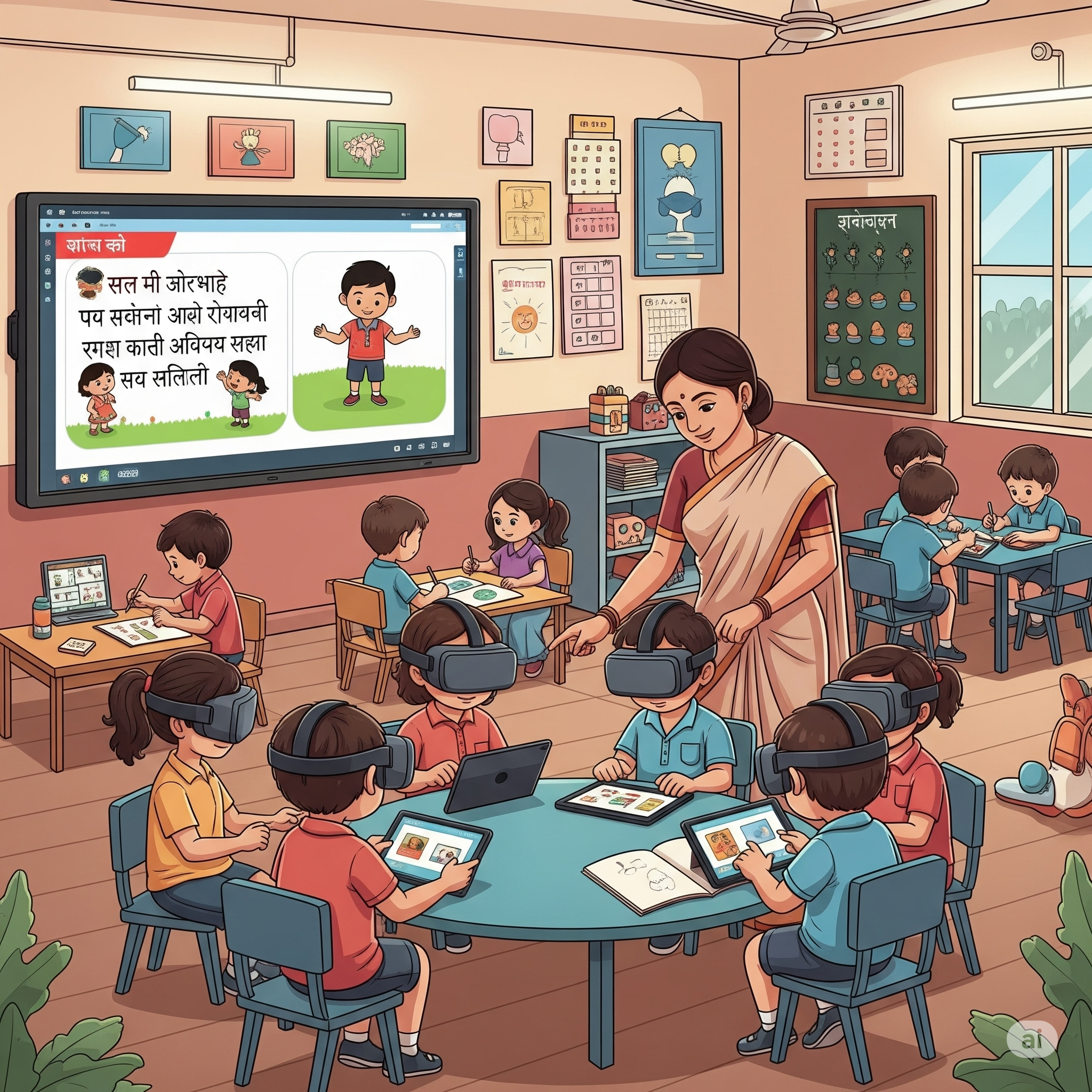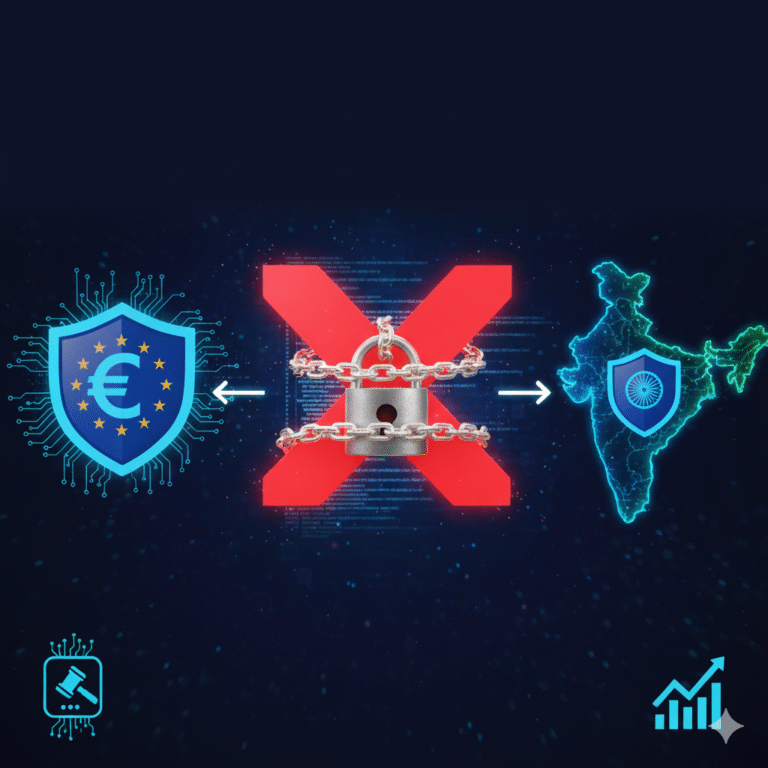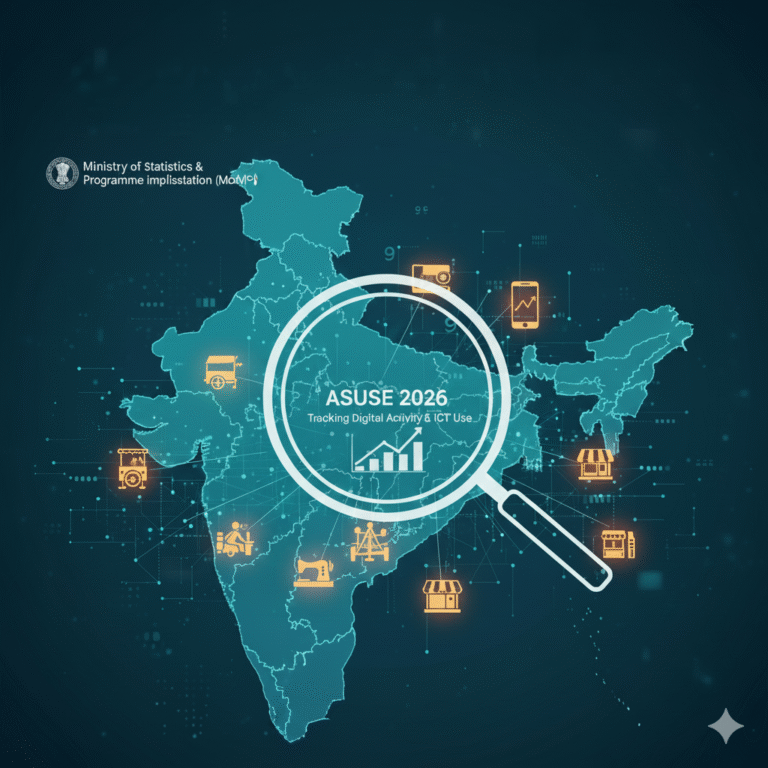India’s early childhood education system has long struggled to bridge the rural–urban divide, with millions of children in villages lacking access to stimulating, modern classrooms. But a bold new chapter is unfolding near Nagpur: the launch of India’s first-of-its-kind AI-driven Anganwadi center in Waddhamna under Maharashtra’s Mission Bal Bharari. With VR headsets, AI-powered smartboards, tablets, and gamified content, this pilot initiative is captivating both children and educators—fueling a surge in attendance and offering a model for tech-powered rural child development nationwide. theweek
Let’s dive into how this center works, what sets it apart, and why it matters for India’s next generation.
Why Early Childhood Education—and Anganwadis—Matter
The first six years of life are critical for brain development, social skills, and lifelong well-being. India’s massive Anganwadi network (over 1.3 million centers) drives early education, nutrition support, and healthcare referrals for rural children. Yet, these centers have battled:
- Limited teaching tools (chalkboards, books, basic toys).
- Irregular attendance—with many kids missing out on the full preschool experience.
- Gaps in health and nutrition monitoring that affect growth and learning.
Mission Bal Bharari: Vision for a Digital Childhood
Launched by the Maharashtra government, Mission Bal Bharari aims to revolutionize rural early childhood education by:
- Infusing classrooms with modern technology and digital content.
- Training Anganwadi workers to become “21st-century educators.”
- Linking learning with real-time health and nutrition tracking.
The new AI-powered Anganwadi at Waddhamna is Mission Bal Bharari’s flagship pilot and a template for the rest of the state.
Bringing AI, VR, and Smartboards to Village Preschools
Inside the Waddhamna Center
- VR Headsets: Children are transported to 3D worlds—exploring animals, outer space, and alphabet adventures in immersive, engaging ways.
- AI-Powered Smartboards: Interactive screens adapt lessons to each child’s learning pace, making classes more individualized and collaborative.
- Tablets: Kids tap, drag, and play through math, language, and logic mini-games.
- Gamified Content: Fun, story-based activities encourage attendance, repetition, and deep learning—vital for building numeracy and literacy skills.
Result:
Children are eager to come to class, with attendance more than doubling since launch. Teachers report greater participation and enthusiasm, even among shy or previously absent students.
Empowering Anganwadi Workers Through Tech Training
Technology is only as good as the people using it. The Waddhamna pilot provided structured, hands-on training for Anganwadi workers, focusing on:
- Using VR and smartboards for interactive learning.
- Incorporating AI-generated lesson plans and feedback loops.
- Troubleshooting technical issues and guiding parents through new tools.
Local teachers feel not just equipped, but empowered—gaining digital literacy skills that benefit the whole community.
Health and Nutrition: Linking the ‘Poshan Tracker’ Platform
Good education goes hand-in-hand with good nutrition. The center integrates with the Poshan Tracker, India’s national child nutrition monitoring system:
- Growth Metrics: Height, weight, and health parameters are logged digitally, making early detection of malnutrition or stunting easier.
- Personalized Recommendations: AI can alert workers if a child needs special attention, nutrition supplements, or health referrals.
Intelligent analytics give caregivers, local healthcare teams, and policymakers real-time insights on child well-being.
Impact and Early Outcomes
- Attendance doubled since the introduction of digital tools and gamified lessons.
- Engagement soared: Even the most introverted children showed marked improvement in participation and confidence.
- Workforce transformation: Anganwadi workers, now tech-savvy, motivate other community members to see value in education and nutrition tracking.
Scaling Up: What’s Next?
Buoyed by the pilot’s success, plans are afoot to scale the model:
- Forty additional centers set to launch across Nagpur district, prioritizing remote, underserved villages.
- State and district authorities are assessing logistical, financial, and training needs for a wider rollout.
If successful, the Waddhamna experiment could influence policy—and inspire similar pilots—in states across the country.
Key Challenges on the Road to Digital Anganwadis
1. Rural Infrastructure
- Electricity & Connectivity: Stable power and internet are not universal—backups and offline-ready content are essential.
- Device Durability: Rural environments demand robust, child-friendly hardware.
2. Digital Literacy
- Both workers and families need ongoing support for using and troubleshooting new tech.
3. Inclusivity
- Content must respect local languages, dialects, and cultural nuances.
- Adaptive AI should account for special needs and avoid bias in lesson recommendations.
4. Data Privacy & Ethical AI
- Health and learning data must be protected, with clear parental consent and transparent usage policies.
Blending Traditions with Technology: The New Rural Classroom

The heart of rural education lies in trust, community, and context. The Waddhamna AI Anganwadi blends:
- Traditional folk stories and songs—digitally gamified and visualized.
- Local context learning: Children learn math using mangoes, not abstract objects.
- Parental involvement: Audio-visual messages keep families informed of progress and opportunities.
Tech is an enabler, not a replacement for the human touch.
Long-Term Promise: A Leap for Bharat’s Youngest Learners
If expanded at scale, India’s AI-driven Anganwadis could:
- Boost school readiness: Giving rural children the skills and confidence to thrive in primary school and beyond.
- Close learning gaps: Bringing city-level teaching tools to every village.
- Strengthen health: Catching and addressing malnutrition and growth concerns early—transforming lives before kindergarten even begins.
Meta Description:
India’s first AI-powered Anganwadi center in Waddhamna village brings VR, smartboards, and gamified learning to rural preschoolers—doubling attendance and transforming early childhood education under Mission Bal Bharari.
Social Media Intro:
AI, VR, and smartboards boost kids’ learning in rural India!
From Chalk to Chips: India’s First AI-Driven Anganwadi Redefines Rural Early Childhood Education
India’s early childhood education system has long struggled to bridge the rural–urban divide, with millions of children in villages lacking access to stimulating, modern classrooms. But a bold new chapter is unfolding near Nagpur: the launch of India’s first-of-its-kind AI-driven Anganwadi center in Waddhamna under Maharashtra’s Mission Bal Bharari. With VR headsets, AI-powered smartboards, tablets, and gamified content, this pilot initiative is captivating both children and educators—fueling a surge in attendance and offering a model for tech-powered rural child development nationwide.
Let’s dive into how this center works, what sets it apart, and why it matters for India’s next generation.
Why Early Childhood Education—and Anganwadis—Matter
The first six years of life are critical for brain development, social skills, and lifelong well-being. India’s massive Anganwadi network (over 1.3 million centers) drives early education, nutrition support, and healthcare referrals for rural children. Yet, these centers have battled:
- Limited teaching tools (chalkboards, books, basic toys).
- Irregular attendance—with many kids missing out on the full preschool experience.
- Gaps in health and nutrition monitoring that affect growth and learning.
Mission Bal Bharari: Vision for a Digital Childhood
Launched by the Maharashtra government, Mission Bal Bharari aims to revolutionize rural early childhood education by:
- Infusing classrooms with modern technology and digital content.
- Training Anganwadi workers to become “21st-century educators.”
- Linking learning with real-time health and nutrition tracking.
The new AI-powered Anganwadi at Waddhamna is Mission Bal Bharari’s flagship pilot and a template for the rest of the state.
Bringing AI, VR, and Smartboards to Village Preschools
Inside the Waddhamna Center
- VR Headsets: Children are transported to 3D worlds—exploring animals, outer space, and alphabet adventures in immersive, engaging ways.
- AI-Powered Smartboards: Interactive screens adapt lessons to each child’s learning pace, making classes more individualized and collaborative.
- Tablets: Kids tap, drag, and play through math, language, and logic mini-games.
- Gamified Content: Fun, story-based activities encourage attendance, repetition, and deep learning—vital for building numeracy and literacy skills.
Result:
Children are eager to come to class, with attendance more than doubling since launch. Teachers report greater participation and enthusiasm, even among shy or previously absent students.
Empowering Anganwadi Workers Through Tech Training
Technology is only as good as the people using it. The Waddhamna pilot provided structured, hands-on training for Anganwadi workers, focusing on:
- Using VR and smartboards for interactive learning.
- Incorporating AI-generated lesson plans and feedback loops.
- Troubleshooting technical issues and guiding parents through new tools.
Local teachers feel not just equipped, but empowered—gaining digital literacy skills that benefit the whole community.
Health and Nutrition: Linking the ‘Poshan Tracker’ Platform
Good education goes hand-in-hand with good nutrition. The center integrates with the Poshan Tracker, India’s national child nutrition monitoring system:
- Growth Metrics: Height, weight, and health parameters are logged digitally, making early detection of malnutrition or stunting easier.
- Personalized Recommendations: AI can alert workers if a child needs special attention, nutrition supplements, or health referrals.
Intelligent analytics give caregivers, local healthcare teams, and policymakers real-time insights on child well-being.
Impact and Early Outcomes
- Attendance doubled since the introduction of digital tools and gamified lessons.
- Engagement soared: Even the most introverted children showed marked improvement in participation and confidence.
- Workforce transformation: Anganwadi workers, now tech-savvy, motivate other community members to see value in education and nutrition tracking.
Scaling Up: What’s Next?
Buoyed by the pilot’s success, plans are afoot to scale the model:
- Forty additional centers set to launch across Nagpur district, prioritizing remote, underserved villages.
- State and district authorities are assessing logistical, financial, and training needs for a wider rollout.
If successful, the Waddhamna experiment could influence policy—and inspire similar pilots—in states across the country.
Key Challenges on the Road to Digital Anganwadis
1. Rural Infrastructure
- Electricity & Connectivity: Stable power and internet are not universal—backups and offline-ready content are essential.
- Device Durability: Rural environments demand robust, child-friendly hardware.
2. Digital Literacy
- Both workers and families need ongoing support for using and troubleshooting new tech.
3. Inclusivity
- Content must respect local languages, dialects, and cultural nuances.
- Adaptive AI should account for special needs and avoid bias in lesson recommendations.
4. Data Privacy & Ethical AI
- Health and learning data must be protected, with clear parental consent and transparent usage policies.
Blending Traditions with Technology: The New Rural Classroom
The heart of rural education lies in trust, community, and context. The Waddhamna AI Anganwadi blends:
- Traditional folk stories and songs—digitally gamified and visualized.
- Local context learning: Children learn math using mangoes, not abstract objects.
- Parental involvement: Audio-visual messages keep families informed of progress and opportunities.
Tech is an enabler, not a replacement for the human touch.
Long-Term Promise: A Leap for Bharat’s Youngest Learners
If expanded at scale, India’s AI-driven Anganwadis could:
- Boost school readiness: Giving rural children the skills and confidence to thrive in primary school and beyond.
- Close learning gaps: Bringing city-level teaching tools to every village.
- Strengthen health: Catching and addressing malnutrition and growth concerns early—transforming lives before kindergarten even begins.
FAQs
How is AI used in the classroom?
AI adapts content to each child’s skill and learning speed, provides real-time feedback to teachers, and helps analyze trends for continuous improvement.
Is technology a distraction for young children?
With trained teachers guiding activities and blending tech with physical play, it’s an enhancement—not a replacement—for hands-on, social learning.
Will parents need to buy devices?
No, all hardware is provided through the center; parents may receive training to support learning at home.
What about children with special needs?
Customizable AI content allows tailored lessons, and accessibility settings can address various learning or physical disabilities.









+ There are no comments
Add yours